Life Cycle of a Student
By: Bill Bull, Blake Kehler, and Colin McElroy
Is emotional distress only likely for students during their first week or so on program? During what part of a program is a student most likely to be the victim of a crime? When on program do behavioral problems usually crop up?
If there is consistency between countries in the answers to questions such as these, we can anticipate issues and better support our students. To this end, CIEE’s Health, Safety, and Security team analyzed a subset of our incident data to see if there are commonalities across locations that correspond with length of time in country. This is our first attempt to more fully understand if there is a student “Life Cycle” — a pattern of behavior and experiences that is likely for any student in a study abroad program regardless of location.
Methodology
For insight into the "Life Cycle" of a student, we chose a cohort of 850 students that attended programs that began in early September 2018 and ended between December 15-24, 2018. The students attended programs in Amman, Barcelona Beijing, Boston, Budapest, Dublin, Ferrara, Lisbon, Moscow, Mumbai, New York, Palma de Mallorca, Paris, Prague, Rabat, Seville, Shanghai, and Warsaw. About 60% of the cohort were either in Barcelona or Prague, so the results are biased toward Europe students in general and those locations in particular. Still, the group provides a good proxy for the larger student body.
The “Life Cycle” described in the graphs below is merely a glimpse at how the semester unfolded for students from a health, safety, and security perspective in Fall of 2018. We will continue to track this type of information and work towards expanding the size of the sampling to determine if indeed we see anything predictive over time.
Health & Behavior "Life Cycle"
Our data revealed that the Fall 2018 cohort experienced health issues early in the program with a peak in a their third to fourth week. Cases dropped after that, drifting downward from week 5 onward. As would be expected, the dominant cases (physician visits and minor illness), largely set the trend for all health cases.
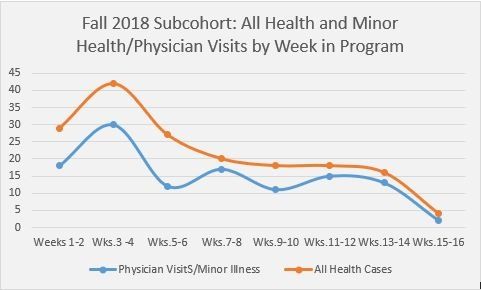
Students reported emotional distress early in the first and second halves of the semester. The cases started high and peaked early, in weeks 3-4. There was a steady drop for a month then a spike in weeks 9-10 before dropping steadily again for the remained of the semester.
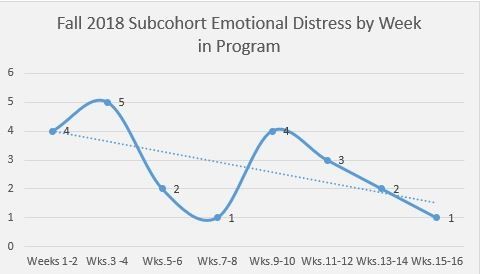
Student behavior issues varied but were most commonly associated with partying, with a third of cases directly citing noise complaints in student housing. Behavioral issues skewed later in the semester. They climbed after the first month and became most common during month three before dropping off again in the final weeks of the semester.
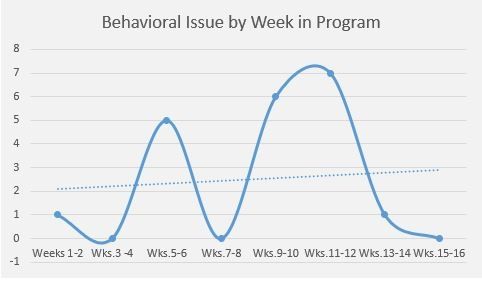
Collectively all of this data suggests that we pay close attention to student’s emotional health at the start of the program and check in again closely just after the mid semester break.
Crime "Life Cycle"
Crime cases in the cohort spiked after the second week of the semester. They decreased slightly through the next six weeks of the semester before another spike then a steep drop in the final month.
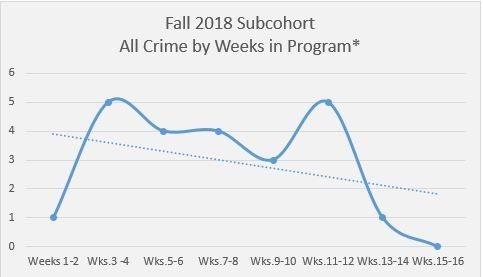
*In the above, ten of the crimes in week 7-8 were reduced to two cases, as they accounted for 10 cases of burglary related to two incidents affecting multiple students.
Petty theft was the most common crime students experienced. Students were most likely to be crime victims going into the weekend, with 44% of crimes occurring on a Friday.
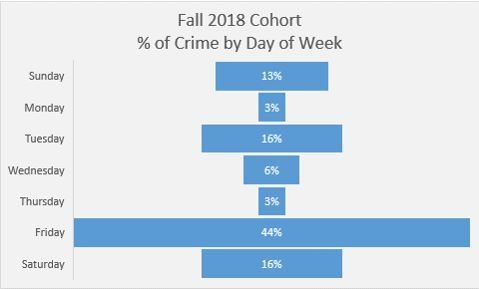
We will of course share the temporal data of when crimes occur with students on arrival and highlight the unique exposures that the weekends seem to bring. Petty theft remains the highest type of crime and seems to peak at three discernable times, at the very beginning, during the semester break and again at the end of the semester. Helping students understand this may well help to them to better safeguard their belongings and remain appropriately attentive.
We will continue to track incident patterns over the course of the next several years and will report out to you all our findings. Together we can work towards our shared goal of a safe, life-changing (in a good way) study abroad experience for all students.
